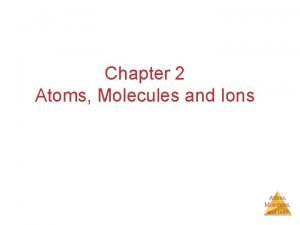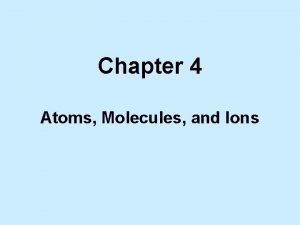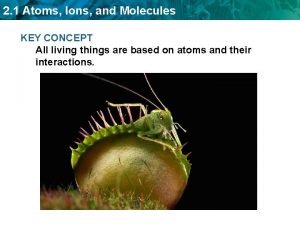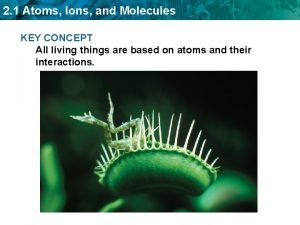2 1 Atoms Ions and Molecules KEY CONCEPT








- Slides: 8

2. 1 Atoms, Ions, and Molecules KEY CONCEPT All living things are based on atoms and their interactions.

2. 1 Atoms, Ions, and Molecules Living things consist of atoms of different elements. • An atom is the smallest basic unit of matter. • An element is one type of atom. Hydrogen atom (H) H Oxygen atom (O) O

2. 1 Atoms, Ions, and Molecules • An atom has a nucleus and electrons. – The nucleus has protons and neutrons. – Electrons are in energy levels outside nucleus. Oxygen atom (O) Nucleus: 8 protons (+) 8 neutrons outermost energy level: 6 electrons (-) inner energy level: 2 electrons (-)

2. 1 Atoms, Ions, and Molecules • A compound is made of atoms of different elements bonded together. – water (H 2 O) _ O H +

2. 1 Atoms, Ions, and Molecules • A compound is made of atoms of different elements bonded together. – water (H 2 O) – carbon dioxide (CO 2)

2. 1 Atoms, Ions, and Molecules • A compound is made of atoms of different elements bonded together. – water (H 2 O) – carbon dioxide (CO 2) – many other carbon-based compounds in living things

2. 1 Atoms, Ions, and Molecules Ions form when atoms gain or lose electrons. • An ion is an atom that has gained or lost one or more electrons. – positive ions – negative ions • Ionic bonds form between oppositely charged ions. gained electron Na loses an electron to CI Sodium atom (Na) Chlorine atom (CI) ionic bond Sodium ion (Na +) Chloride ion (CI -)

2. 1 Atoms, Ions, and Molecules Atoms share pairs of electrons in covalent bonds. • A covalent bond forms when atoms share a pair of electrons. – multiple covalent bonds – diatomic molecules covalent bonds Oxygen atom (O) Carbon atom (C) Carbon dioxide (CO 2 ) Oxygen atom (O)














